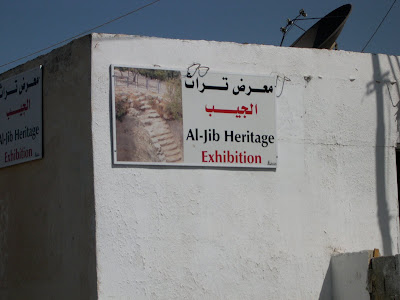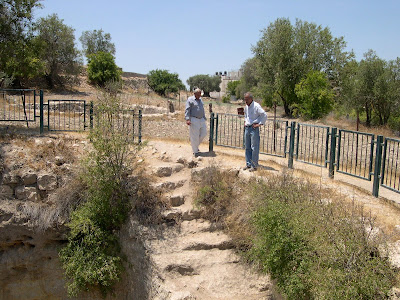We have just passed the halfway point for the Marj Rabba excavation season, and our team is making wonderful progress. The architectural preservation is quite good, and the flint, pottery and animal bones are plentiful. We have an amazing team that puts in long days of work, starting at 5 am, six days a week.
 Some of our readers know very well what working on an excavation entails (indeed, some might be the very people who introduced us to the routine and different field methods!) But for those who have never worked on an excavation, we thought that we could run down the daily routine.
Some of our readers know very well what working on an excavation entails (indeed, some might be the very people who introduced us to the routine and different field methods!) But for those who have never worked on an excavation, we thought that we could run down the daily routine.
In order to avoid the hottest part of the day, we start very early; Mo and Yo get up at 4 am, so that we have our own gear together (hats, water, cameras, etc). This year we are staying at a college in Karmi'el called ORT Braude, a small engineering college.
 ORT Braude campus
ORT Braude campus
We walk over to where we park the vehicles, which is near the dormitory rooms. After collecting empty buckets, water jugs and gear for the field, we hope everyone arrives by our 5 am departure. A quick 10 minute drive through the winding roads leading to Yodefat takes us to Marj Rabba, where our rented container containing the tools is stationed. At this point the sun is just about to rise, but by the time we get the tools out and walk them up to the site, there is just enough light to begin working.
 MP and Mo discussing bucket tags and the day's goals
MP and Mo discussing bucket tags and the day's goals
 Pre-dawn excavations.
Pre-dawn excavations.
Like last year, we often have some fog up on our hill, and we can hear the peacocks from Kibbutz Yodefat as we discuss our plans for the day.
 Mo in the mist
Mo in the mist
This year we have opened four new 5 x 5 meter squares, plus two half squares (2.5 x 5). We have some walls that are not doing quite what we expected (rectangular rooms are standard for the Chalcolithic, but these are not so clear - yet!).
 We work until 8:30, when we stop for breakfast under the nearby olive trees, which includes a variety of sandwiches, veggies, cookies and beverages prepared at the ORT Braude cafe which we pick up on our way out. A little after 9 we go "back to the salt mines", until 11, when we have a short fruit break. By 12:30 we are wrapping things up - taking elevations, sweeping up the excavation areas, collecting the buckets and bone bags, and moving the equipment back to the container, so that we can finish by 1 pm. The day goes by very quickly, usually, but we are all tired.
We work until 8:30, when we stop for breakfast under the nearby olive trees, which includes a variety of sandwiches, veggies, cookies and beverages prepared at the ORT Braude cafe which we pick up on our way out. A little after 9 we go "back to the salt mines", until 11, when we have a short fruit break. By 12:30 we are wrapping things up - taking elevations, sweeping up the excavation areas, collecting the buckets and bone bags, and moving the equipment back to the container, so that we can finish by 1 pm. The day goes by very quickly, usually, but we are all tired.
Because we are sieving 100% of the current excavation areas, we get quite dirty as the dust is unavoidable. We then head to a restaurant where we have "lunch" - a large hot meal - and can relax. We finally return to ORT Braude by about 3 pm for showers, some quiet time or a nap.

 Pottery washing time near the dormitories at ORT Braude.
Pottery washing time near the dormitories at ORT Braude.
But wait, there's more! All of the pottery, flint and animal bone needs to be washed, then dried, then returned to the bags. At 5 or 5:30 we reconvene to wash this material culture, to bag up the dry material from the day before, and to make day plans for the next day. By 7 we are done, and have a light meal.
At the end of each week, we have short tours of the different areas so that we all know what is going on each area. Here we see MP discussing their amazing progress in square B1, where they moved unimpeded by walls or other architecture.

And below we see A "C" H discussing the results of their area, where a profusion of architectural remains will prove a challenge to understand!

Some of us are finished (that is, wiped out!) by about 9 pm, while others go out and sample the club life in Karmi'el. Ok, perhaps not so many go out clubbing in Karmi'el. We aren't so sure that there is any clubbing in Karmi'el. A major annual 3 day dance festival just ended here in Karmi'el, but as most events began late at night, our group seemed a bit too tired for this entertainment.
Of course, if we did more clubbing, or at least visited the dance festival, we might have seen our resident celebrity, staying at ORT Braude.
 Yes, we were told that Samantha Fox was staying on the ORT Braude campus while we were here. She was in Karmi'el for the dance festival, but we didn't see her. We hope her room had some AC, because rumor has it that spandex can be quite hot in humid weather. We are now in the home stretch and beginning the "big push", where we hope to expose some floor or surface levels corresponding the architecture, to understand the area outside of the architectural complex, and to recover some carbonized remains. Wish us luck as we attempt to pull all of this together in only about 10 days of excavation time!
Yes, we were told that Samantha Fox was staying on the ORT Braude campus while we were here. She was in Karmi'el for the dance festival, but we didn't see her. We hope her room had some AC, because rumor has it that spandex can be quite hot in humid weather. We are now in the home stretch and beginning the "big push", where we hope to expose some floor or surface levels corresponding the architecture, to understand the area outside of the architectural complex, and to recover some carbonized remains. Wish us luck as we attempt to pull all of this together in only about 10 days of excavation time!































































